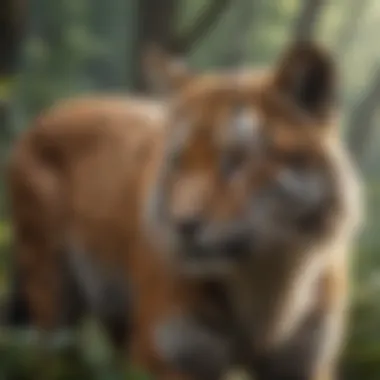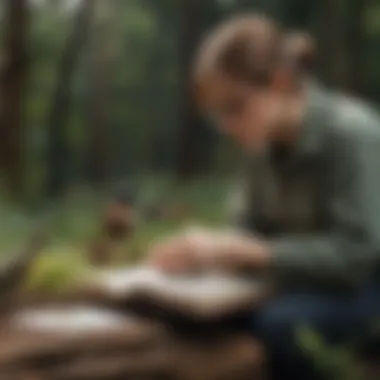Discover Free Online Nonfiction Books About Animals


Nature Topic Overview
Understanding the animal kingdom is crucial for nurturing an informed and compassionate perspective towards wildlife. Nonfiction books play an essential role in this educational journey. This article explores the vast array of free online resources that provide access to informative literature about animals. Parents, teachers, and young readers can find valuable materials that cover various themes such as biodiversity, conservation, and wildlife habitats. This literature serves not only as a means to learn but also as a method to cultivate empathy and awareness about the roles animals play in our ecosystem.
Importance of Nonfiction Literature
Nonfiction texts about animals enable readers to explore factual information, scientific research, and engaging stories about diverse species. This genre encourages critical thinking and inquiry among young learners. It also introduces them to vital topics such as ecological responsibility. The easy accessibility of these books enhances their educational experience, making complex subjects approachable and engaging.
Fun Facts and Trivia
To capture the interest of young readers, it's essential to present fascinating facts about animals. Here are some engaging tidbits:
- Did you know that sea otters hold hands when they sleep to prevent drifting apart?
- Elephants can recognize themselves in mirrors, showcasing their high intelligence.
- A group of flamingos is called a "flamboyance".
Such information sparks curiosity and encourages readers to delve deeper into specific topics. Accompanying these facts with visuals, like photographs of the animals, can enhance the learning experience, making it more interactive. Online platforms often provide multimedia resources that complement written material.
"Nonfiction books are gateways to discovery, revealing the diverse wonders of our planet's animal life."
Wildlife Explorations
Wildlife explorations introduce readers to various species and their habitats. Resources available online often categorize animals based on their ecosystems—forests, oceans, deserts, and grasslands. Visitors can learn about:
- Rainforest: The jaguar, sloth, and poison dart frog.
- Ocean: The blue whale, clownfish, and octopus.
- Desert: The camel, meerkat, and rattlesnake.
By diving into these subjects, young readers grasp the interconnectedness of life forms. Additionally, interactive features such as quizzes or puzzles reinforce learning by testing knowledge and enhancing retention. This approach allows learners to engage actively rather than passively absorbing information.
Environmental Awareness
Educating young readers about animals goes hand in hand with fostering a sense of environmental stewardship. Understanding the importance of conservation is vital. Here are key aspects to consider:
- The role of animals in their ecosystems.
- The impact of human activities on wildlife populations.
- Practical tips for how children can contribute to conservation efforts, such as:
- Reducing waste and recycling.
- Participating in local clean-up events.
- Observing wildlife respectfully without disturbing their habitats.
Encouraging awareness will inspire children to care for their surroundings, developing a more sustainable mindset toward nature.
DIY Nature Activities
Engaging in hands-on nature activities is an effective way to reinforce learning. Here are some simple ideas for exploring nature at home:
- Create a Nature Journal: Kids can draw or write about different animals they observe in their backyard or neighborhood parks.
- Build a Bird Feeder: Using recyclable materials, children can create feeders to attract local birds, learning about different species.
- Nature Walk Scavenger Hunt: Develop a list of items for a scavenger hunt, including various leaves, rocks, or animal tracks.
These activities foster creativity and deepen understanding of the natural world. By observing and interacting with their environment, children build valuable connections between knowledge and experience.
Preface to Nonfiction Animal Literature
The study of nonfiction animal literature serves a pivotal role in expanding knowledge about the diverse species that share our planet. These books allow readers, particularly younger audiences, to explore the intricate lives of animals beyond mere facts. They weave narratives backed by research and observations, fostering a deeper understanding of the natural world. The significance of these literary works is not only found in the information they provide but also in the way they ignite curiosity and inspire action towards wildlife conservation.
Definition and Importance of Nonfiction
Nonfiction books are factual works that present real events, people, and realities. Unlike fiction, they rely on evidence, research, and documented observations. In the realm of animal literature, nonfiction books educate readers about various aspects of animal life. This can include anatomical features, habitats, behaviors, and the ecological significance of different species. The importance of nonfiction lies in its capacity to cultivate informed perspectives. For children aged 5 to 12, understanding factual content translates to a greater appreciation for animals and their environments. Consequently, this knowledge forms the foundation for responsible stewardship of nature.
The Appeal of Animal Stories


Stories about animals appeal to readers for several reasons. They present relatable themes, such as survival, friendship, and the struggle for existence. Children are often fascinated by the behaviors and traits of different animal species. Nonfiction animal literature presents these stories grounded in reality, enhancing their interest. Furthermore, these books often portray animals in vivid context, enabling children to connect emotionally with the subjects. This emotional engagement can motivate young readers to explore further, fostering a sense of responsibility and advocacy for wildlife. As they learn about the animal kingdom through nonfiction, children can envision themselves as protectors of nature, which is crucial in our rapidly changing world.
"Reading nonfiction books about animals not only informs young minds but also inspires future generations of conservationists."
In essence, the introduction to nonfiction animal literature lays a valuable groundwork for understanding and appreciating wildlife. It provides a rich tapestry of knowledge that emphasizes the inherent value of all living creatures. This foundational understanding is paramount for the young readers, parents, and educators alike, as it encourages curiosity as well as responsible actions in the real world.
Benefits of Reading Nonfiction About Animals
Reading nonfiction books about animals offers numerous advantages that go beyond mere entertainment. This genre serves as a bridge to understanding the ecological, biological, and ethological principles that explain the natural world. For parents, educators, and young learners alike, the experience of delving into nonfiction animal literature can foster deeper connections to the subjects of biodiversity and conservation. Here are some key benefits:
- Familiarity with Scientific Terms: By engaging with nonfiction texts, readers become familiar with terminology and concepts that define the study of animals and their habitats.
- Awareness of Global Issues: Many nonfiction books address urgent topics such as habitat loss and climate change, which can imbue young learners with a sense of responsibility towards the planet.
Enhancing Knowledge and Understanding
The primary advantage of reading nonfiction about animals is the enhancement of knowledge. Nonfiction books often include meticulously researched information from reliable sources. This is particularly crucial for the age group of 5-12 years, where foundational knowledge about the animal kingdom can be established. Young readers learn about different species, their ecosystems, and survival strategies. Incorporating facts, figures, and real-world examples solidifies understanding.
A well-structured nonfiction book captures the multifaceted nature of animal life.
"Reading nonfiction increases awareness and appreciation for the diversity that exists in the natural world."
Children become more observant of their surroundings. They can recognize animals they encounter in parks or zoos thanks to what they have learned. This awareness leads to greater curiosity, prompting them to ask questions and seek answers. Developing this curiosity is essential for lifelong learning.
Fostering Curiosity and Critical Thinking
Curiosity is a powerful driver of learning. Nonfiction books about animals inspire questions. Kids may wonder about why certain animals have specific adaptations or how ecosystems function. This stimulates critical thinking as they link various concepts to create a broader understanding of the world. Encouraging children to think about these questions helps them develop analytical skills.
When provided with interconnected themes—such as animal behaviors, habitats, and conservation efforts—readers can contemplate the larger picture. This leads to critical discussions, often facilitated by parents or educators, about the significance of protecting endangered species or understanding migration patterns.
In summary, reading nonfiction about animals is not just about gaining facts. It’s about nurturing a mindset that embraces inquiry and exploration. This essential benefit shapes future generations' attitudes toward the environment.
Finding Free Nonfiction Animal Books Online
Finding free nonfiction animal books online is a vital aspect of accessible education. The vast array of literature available is not only beneficial for individual learning but also serves as an excellent resource for educators and parents. In a world where cultivating a love for reading and learning is essential, these books provide an invaluable gateway into the diverse topics that cover wildlife, conservation, and biology.
By accessing these materials online, children aged 5-12 can explore various facets of the animal kingdom without any finacial barrier. This helps to foster a climate of curiosity and engagement in young learners. Furthermore, free access encourages independent reading habits and a deeper understanding of ecosystems, promoting lifelong learning.
Reputable Websites Offering Free Access
Several websites stand out as remarkable resources for finding free nonfiction animal books. Project Gutenberg is one such platform. It offers thousands of eBooks, including a diverse selection of nonfiction texts focused on animals. Works by well-known naturalists and scientists, like John Burroughs and Ernest Thompson Seton, are available to read online or download.
Another worthy mention is Open Library. This initiative provides access to millions of books, which include various titles on animals and nature. Users can borrow digital books, broadening their understanding of different species and habitats.
National Geographic Kids provides an engaging platform, too. Here, children can find articles and features on various animals, accompanied by stunning visuals that capture their attention.
Lastly, Oceanic Society offers an extensive collection of resources related to marine wildlife, allowing readers to learn about ocean conservation and the species that inhabit these crucial ecosystems. All these websites ensure that reliable information is just a click away.
E-Books and PDFs for Easy Access
E-books and PDFs are essential for convenient access to nonfiction about animals. These formats allow users to download literature on various devices, making it easier to read on-the-go or at home. One reputable platform for accessing free eBooks and PDFs is the Google Books repository. Here, countless nonfiction texts can be previewed or downloaded for full access, often including educational resources about animal behavior and habitat.
Internet Archive is another resource highlighting the significance of eBook availability. By digitizing many print and analog works, it has turned into a treasure trove of accessible literature, including information on biodiversity and conservation efforts.
By utilizing these resources, young learners can broaden their horizons without deepening their parent's pockets. E-books and PDFs enhance the ability to explore the natural world through engaging and interactive reading experiences.


Key Features of Quality Nonfiction Animal Books
Quality nonfiction animal books should have specific features that distinguish them from other types of literature. These books are not only informative but also serve as vital educational tools for young readers. Understanding these key characteristics can help educators, parents, and young learners choose the right materials that provide accurate insights into the animal kingdom.
Accurate Information and Reliable Sources
One of the most crucial aspects of quality nonfiction animal literature is the accuracy of its content. Information in these books should be well-researched and sourced from reputable organizations or experts in the field. Well-regarded sources can include universities, research institutions, or organizations such as World Wildlife Fund or National Geographic.
To ensure the reliability of the materials, readers should look for citations and references. Books that provide a bibliography or mentions of scientific articles often contain more credible information. Labelling these sources allows readers to delve deeper into the subjects that interest them. The accuracy of the information contributes to a better understanding of animals and their environments, which is essential for fostering a good knowledge base.
Additionally, accurate information helps establish trust between the reader and the material. Children can become confident in the knowledge they gain and develop a keen interest in wildlife and conservation. This trust is also vital for educators as they aim to impart knowledge based on facts to their students.
Engaging Imagery and Layout
The presentation of nonfiction animal books plays a significant role in capturing a reader's interest. Engaging imagery is one feature that can make a book more appealing. High-quality photographs, illustrations, and diagrams can enhance the content by providing visual context. These images not only attract attention but also assist in understanding complex processes or features of different animals.
In addition to visuals, the layout of the book is important. Clear organization with well-defined sections, headers, and sub-headers helps guide readers through the text effectively. Consistent formatting makes it easier for young learners to navigate the content and engage with the material.
Furthermore, incorporation of interactive elements, like questions or prompts, invites readers to reflect and think critically about what they are learning. This engagement is particularly effective in a classroom setting. Importantly, readable font and appropriate color schemes can aid in retention of information, allowing readers to absorb facts with greater ease.
"Quality nonfiction literature educates while captivating the reader's attention, ensuring a lasting impact on their understanding of the animal kingdom."
Diverse Themes in Nonfiction Animal Literature
Nonfiction animal literature is rich with variety. This section examines different themes in this genre. Each theme serves a unique purpose in enhancing understanding of the animal world. Exploring these themes helps readers appreciate the nuances of wildlife and fosters a deeper connection with nature. They also allow for broader discussions on conservation, biodiversity, and the impact humans have on ecosystems.
Wildlife and Biodiversity
Wildlife and biodiversity are central themes in nonfiction books. These topics discuss the variety of species that exist in the natural world. Reading about wildlife encourages curiosity in young readers. They learn about animals' habitats, behaviors, and roles in their ecosystems. Books like "The Animal Book" by David Burnie show various species and emphasize the importance of each in maintaining ecological balance.
Understanding biodiversity helps children recognize that every creature, big or small, plays a role in the Earth's health. Learning about endangered species also cultivates empathy. Children can understand that many animals are at risk due to activities like deforestation, pollution, and climate change. It teaches them to care for the environment they share with these creatures.
Conservation Efforts and Environmental Impact
The theme of conservation is crucial in animal literature. It sheds light on the ongoing efforts to protect endangered species and their habitats. Informative books showcase initiatives that aim to restore biodiversity. They often feature organizations like the World Wildlife Fund and their projects to support various species.
Readers learn about the importance of sustainable practices. Understanding how human actions impact the environment is vital. Books reveal the consequences of pollution, hunting, and habitat destruction. Moreover, engaging with such literature inspires readers to take action. Simple steps, like reducing waste or supporting conservation programs, can impact broader issues.
Habitats and Ecosystems
The exploration of habitats and ecosystems is another significant theme in nonfiction animal literature. These topics cover the various environments where animals thrive, from forests to deserts. Knowing about different habitats helps children visualize where animals live and how they adapt to their surroundings.
Books often provide details on how ecosystems function as interconnected systems. Each part of an ecosystem, including plants, animals, and even rocks, plays a role. This interdependence is crucial for maintaining balance in nature. Reading about various ecosystems encourages children to appreciate the complexity of life around them.
Animal Behavior and Adaptations
Understanding animal behavior and adaptations is essential in nonfiction literature. This theme highlights how animals interact with their environment and each other. Books cover topics like migration, hibernation, and social behavior, offering insight into why animals act as they do.
Adaptations are fascinating subjects, too. They explain how species develop traits to survive. For instance, a polar bear's thick fur or a chameleon's color-changing ability can captivate young minds. Such information can lead children to inquire further, prompting independent research and discussions.
"Understanding animal behavior fosters empathy and respect for all creatures."
In summary, exploring diverse themes in nonfiction animal literature enriches the reading experience. It empowers children to understand better the animal kingdom. Each theme contributes essential knowledge, inspires curiosity, and cultivates a sense of responsibility toward wildlife and the environment.


Integrating Nonfiction Animal Books into Education
Incorporating nonfiction animal books into the education framework offers numerous advantages. These resources foster a deeper understanding of the animal kingdom while enhancing critical thinking and creativity among students. Such books not only provide factual information but also facilitate discussions surrounding animals and their habitats. For educators, these texts serve as a rich foundation to stimulate engagement and encourage inquiry-based learning.
By using nonfiction books about animals, teachers can introduce various themes like wildlife conservation, animal behavior, and ecosystems. This integration into the curriculum ensures that students can relate their learning to real-world issues. Moreover, exposing students to a wide variety of writing styles and presentations can help shape their reading preferences and comprehension skills as they explore the natural world through factual literature.
Classroom Activities and Projects
Using nonfiction animal books in classroom activities can bring the animal world to life. Here are some ideas:
- Animal Research Projects: Have students select an animal they are interested in. They can read about it through chosen nonfiction books and create a presentation or poster. This exercise not only builds their research skills but also promotes public speaking.
- Book Clubs: Organizing a book club focusing on a single nonfiction animal book encourages group discussions. Students can share their thoughts and insights, fostering a collaborative learning environment.
- Creative Writing: After reading a nonfiction book, students can write a story or an informative piece about the animal. This allows for practice in different writing styles while reinforcing the knowledge acquired.
- Art Projects: Students can create art inspired by the animal they studied. This could involve drawing, painting, or even creating a model, allowing for creative expression linked to their reading.
These activities not only reinforce the content but also make learning enjoyable and interactive.
Encouraging Independent Research
Encouraging students to engage in independent research through nonfiction animal literature is vital. This approach nurtures a sense of curiosity and responsibility for their own learning. Here are some strategies:
- Resource Selection: Guide students to navigate reputable websites and databases where they can find quality nonfiction materials. Initiating the search process cultivates autonomy in their research efforts.
- Guided Questions: Provide students with specific questions to guide their exploration. Focusing on particular aspects of animal life encourages critical thinking and a structured approach to information gathering.
- Journaling: Ask students to maintain a research journal. Noting down interesting facts and insights from their readings can aid in retention and reflection on the material.
- Sharing Findings: Integrate activities where students share what they learned independently. This could be in the form of presentations or discussions, promoting retention and comprehension of the subject matter.
Promoting independent research via nonfiction animal books equips students with essential skills they can apply throughout their academic careers.
Interactive Learning with Digital Formats
In today's digital age, interactive learning has emerged as a pivotal approach to education, especially in the realm of nonfiction literature. This is particularly true for books about animals, which can captivate young minds while also imparting crucial factual knowledge. Digital formats allow students to engage with the content in a way that traditional printed materials may not. The combination of text, images, audio, and interactive elements creates a learning experience that is immersive and engaging.
Use of Multimedia in Nonfiction Animal Books
Multimedia refers to the integration of various content forms. In the case of nonfiction animal books, this can mean combining written text with images, videos, and sound clips. Such integration greatly enhances the learning environment. For instance, seeing the high-definition visuals of animals in their natural habitats can deepen a child's appreciation and understanding of biodiversity.
Some benefits of multimedia include:
- Visual Learning: Children are often more responsive to visual stimuli, making images and videos effective teaching tools.
- Audio Support: Many digital books come with narration options, which can assist children who may struggle with reading.
- Interactive Features: Quizzes and games embedded within the content can reinforce learning and make it more enjoyable.
All these elements work together to turn passive reading into an active learning experience, reinforcing the themes covered in the books.
Benefits of Reading on Digital Devices
Engaging with nonfiction animal books on digital devices offers several advantages. First, accessibility plays a significant role. Readers can access a vast array of resources from different platforms, such as Wikipedia and Britannica, enabling them to explore topics in depth without physical limitations.
Other benefits include:
- Portability: Digital devices make it possible to carry multiple books at once, ideal for young learners on the go.
- Customization: Many e-readers allow users to adjust text size, background color, and font, catering to individual learning preferences.
- Instant Updates: Digital content can be revised instantly, ensuring that readers have the most current information available, especially important in fields like animal conservation.
The End: The Value of Nonfiction in Understanding Animals
Nonfiction books play a crucial role in shaping our understanding of the animal kingdom. These resources provide factual insights that enable readers to engage critically with the topic. In today’s world, where misinformation can spread rapidly, having access to reliable nonfiction materials is essential. It cultivates informed readers who understand the complexities of animal life.
Encouraging Lifelong Learning
Reading nonfiction about animals encourages lifelong learning. For children aged 5-12 years, this is an important development stage. Nonfiction books introduce young readers to various animal species, their habitats, and behaviors. These topics spark curiosity. When children learn about animal adaptations or conservation efforts, they begin to see the importance of biodiversity.
Moreover, nonfiction literature presents information in an accessible way. It often includes visuals, graphs, and maps that enhance comprehension. This multimedia approach makes learning more engaging and helps young readers retain information better. The habit of reading nonfiction continues as they grow. Hence, it nurtures a generation that values knowledge and seeks to understand the world around them.
The Role of Parents and Educators
Parents and educators hold significant influence in directing children’s reading habits. By incorporating nonfiction books into their instruction, they lay a foundation for informed citizenship. Parents should encourage reading nonfiction books about animals at home. This can lead to conversations about environmental stewardship and animal welfare.
Educators play a pivotal role in integrating these resources into their curriculum. Creative classroom activities based on nonfiction readings can enhance engagement. For instance, discussions about the migration patterns of animals or the impact of poaching can ignite students' passion for wildlife. Educators can also guide students in conducting independent research, allowing them to explore topics in greater depth.







